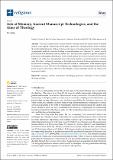Files in this item
Arts of memory, ancient manuscript technologies, and the aims of theology
Item metadata
| dc.contributor.author | Lang, T.J. | |
| dc.date.accessioned | 2022-05-09T09:30:32Z | |
| dc.date.available | 2022-05-09T09:30:32Z | |
| dc.date.issued | 2022-05-08 | |
| dc.identifier | 279256449 | |
| dc.identifier | 1a58ba8f-d8de-406f-b33a-413b04e5ef5a | |
| dc.identifier | 85130259479 | |
| dc.identifier | 000802651600001 | |
| dc.identifier.citation | Lang , T J 2022 , ' Arts of memory, ancient manuscript technologies, and the aims of theology ' , Religions , vol. 13 , no. 5 , 426 . https://doi.org/10.3390/rel13050426 | en |
| dc.identifier.issn | 2077-1444 | |
| dc.identifier.other | ORCID: /0000-0003-2467-3501/work/113061056 | |
| dc.identifier.uri | https://hdl.handle.net/10023/25318 | |
| dc.description.abstract | This article explores how ancient rhetorical theories about the improvement of human memory were applied to manuscripts in the form of paratextual ordering systems. It then considers the intellectual implications of these technological changes in the management of textual knowledge. A sequentially ordered system for dividing textual information into “chapters” or “verses” proved powerful for both mnemonic arts and textual arts. The article next explores a specific example of paratextual technologies in Priscillian of Avila’s fourth-century CE Canones Epistularum Pauli Apostoli, which is one of the most sophisticated cross-referencing systems ever produced prior to printed texts. The article concludes by reflecting on the implications of textual divisions and citation schemes for the work of theology. The test case for this is Priscillian’s “versification” of the Pauline corpus for purposes of textual abstraction (the extraction and reorganization of numerically divided textual parts) in service of theological abstraction (the attempt to create systematic wholes out of the newly reorganized parts). | |
| dc.format.extent | 13 | |
| dc.format.extent | 1344997 | |
| dc.language.iso | eng | |
| dc.relation.ispartof | Religions | en |
| dc.subject | Memory | en |
| dc.subject | Rhetoric | en |
| dc.subject | Manuscript technologies | en |
| dc.subject | Paratexts | en |
| dc.subject | Priscillian of Avila | en |
| dc.subject | Pauline theology | en |
| dc.subject | Theology | en |
| dc.subject | BL Religion | en |
| dc.subject | Religious studies | en |
| dc.subject | T-NDAS | en |
| dc.subject | MCC | en |
| dc.subject.lcc | BL | en |
| dc.title | Arts of memory, ancient manuscript technologies, and the aims of theology | en |
| dc.type | Journal article | en |
| dc.contributor.institution | University of St Andrews. School of Divinity | en |
| dc.identifier.doi | 10.3390/rel13050426 | |
| dc.description.status | Peer reviewed | en |
This item appears in the following Collection(s)
Items in the St Andrews Research Repository are protected by copyright, with all rights reserved, unless otherwise indicated.

